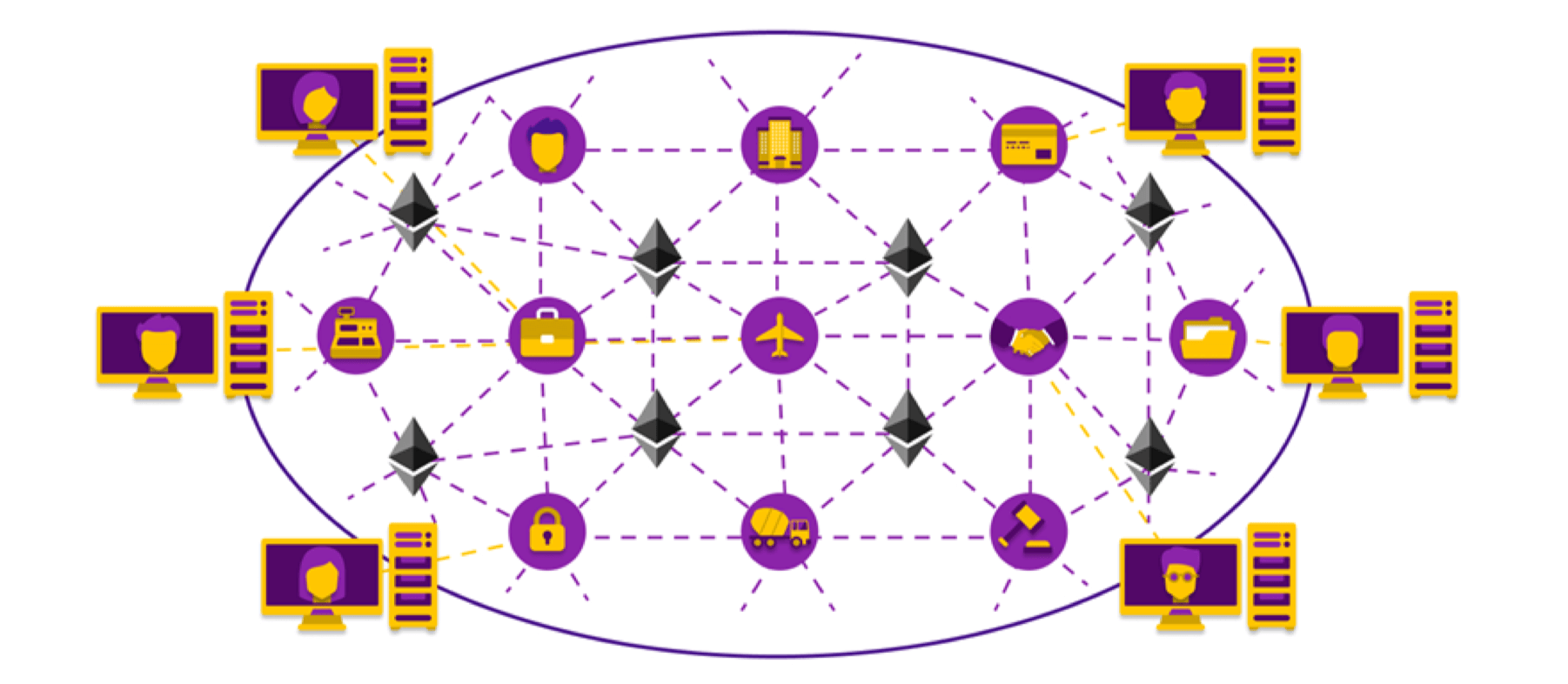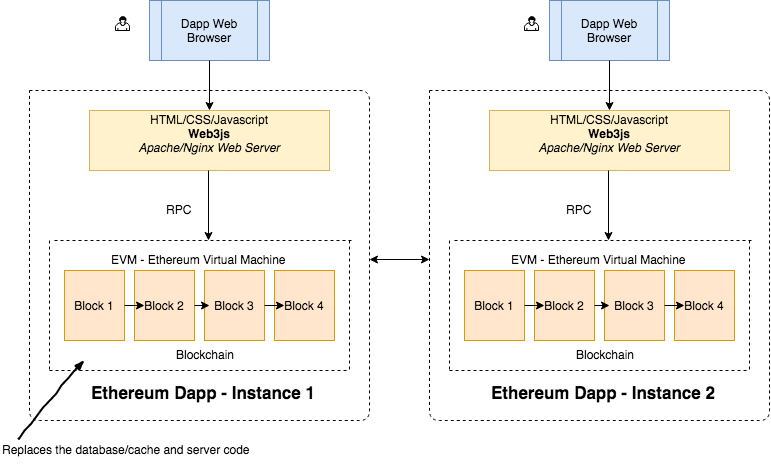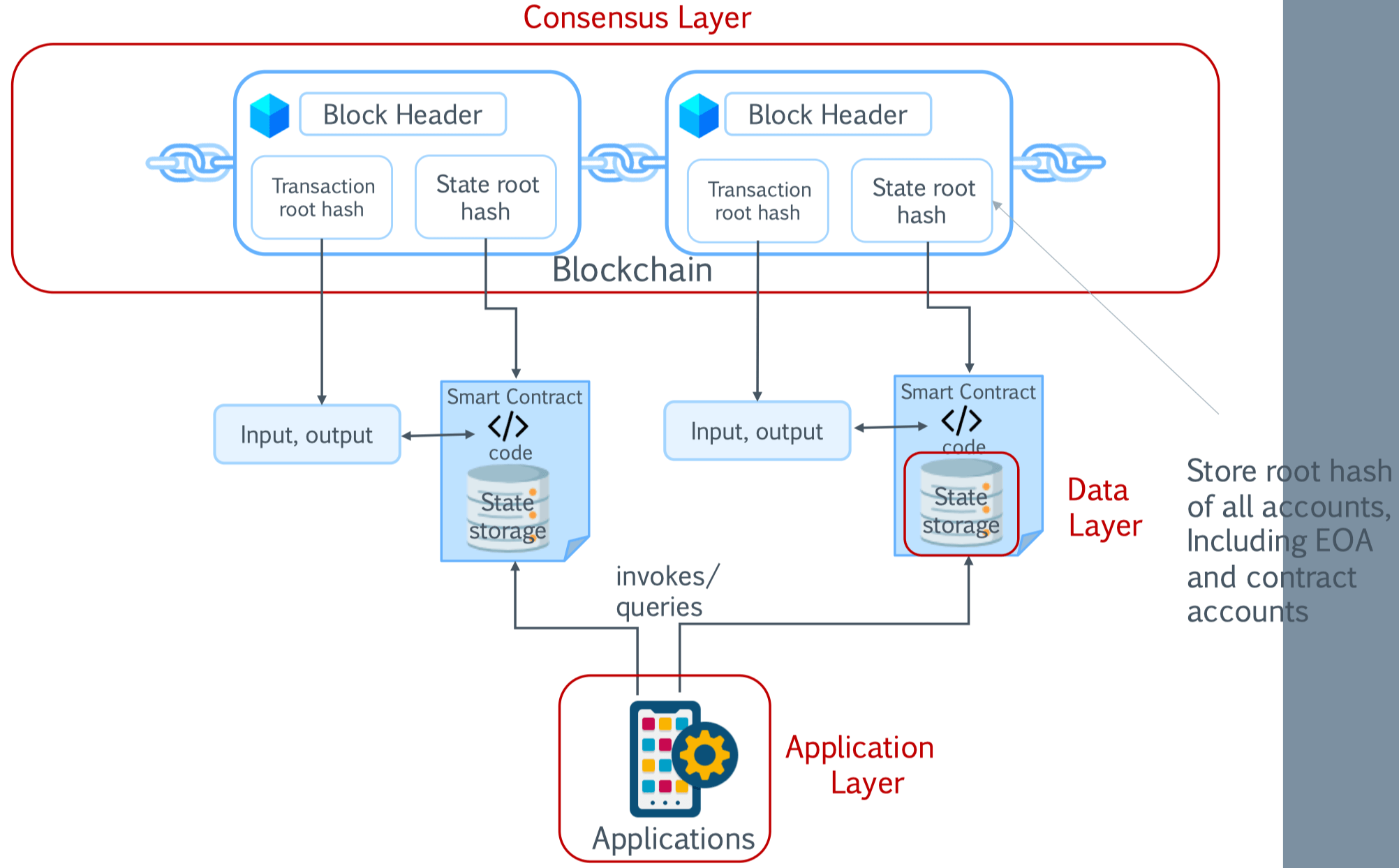前言 #
比特币作为一种去中心化的数字货币,是极其成功的,但受限于比特币脚本(非图灵完备,只能处理一些简单的逻辑),并不能处理很复杂的业务。而Ethereum引入了智能合约,使去中心化的概念能够应用于更丰富的应用场景,因此也被称为区块链 2.0。本文将对以太坊核心技术进行解读,如有错漏,欢迎交流指正。
Ethereum 系统 #
2014 年 1 月,俄罗斯开发者 Vitalik Buterin 发布了以太坊白皮书并成立团队,旨在创造一个集成更通用的脚本语言的区块链平台。其中一位成员 Dr. Gavin Wood 发布了一份黄皮书,涉及Ethereum Virtual Machin(EVM)以太坊虚拟的相关技术,这就是Ethereum的诞生。

简单来说,Ethereum是一个开源的去中心化系统,使用区块链来存储系统状态变化,因此也被称为“世界计算机”;它支持开发者在区块链上部署运行不可变的程序,称为智能合约,因此可以支持广泛的应用场景;它使用数字货币Ether来衡量系统资源消耗,激励更多人参与Ethereum系统建设。
去中心化应用 DApp #
狭义来说,DApp 其实就是一个集成了用户界面、支持智能合约、运行于以太坊区块链上的应用。

如上图所示,Ethereum应用实例部署在区块链网络上(智能合约运行于区块链虚拟机中),而 Web 程序只需要通过Web3.js对区块链网络进行RPC远程调用,这样用户就可以通过浏览器(DApp 浏览器或 MetaMask 等插件工具)访问去中心化服务应用了。
账本 #
Ethereum区块链是一个去中心化的账本(数据库),网络中的所有交易都会存储在区块链中,所有节点都要本地保存一份数据,并且确保每一笔交易的可信度;所有的交易都是公开且不可篡改的,网络中的所有节点都可以查看和验证。
账户 #
当我们需要登录一个网站或系统(比如邮箱)时,往往需要一个帐号和一个密码,密码通过加密算法以暗文的形式存储在中心化的数据库中。然而,以太坊是一个去中心化的系统,那是怎么生成账户的呢?
和比特币系统原理类似
- 首先生成一个仅有自己知道的私钥,假设为
sk,采用ECDSA(Elliptic Curve Digital Signature Algorithm)椭圆曲线算法生成对应的公钥pk - 采用
keccak256算法对公钥pk求哈希值 - 截取后 160 位作为以太坊的地址
用户的私钥和地址一起组成了以太坊的账户,可以存储余额、发起交易等(比特币的余额是通过计算所有的UTXO得到的,而不是像以太坊一样存储在账户中)。
其实Ethereum账户分为两种类型,上述方式生成的叫Externally Owned Accounts(EOA),外部账户,也就是常规用户拥有的账户,主要是用来发送/接收Ether代币或者向智能合约发送交易(即调用智能合约)。
而另一种则是Contract Accounts,合约账户,不同于外部账户,这种账户是没有对应的私钥的,而是在部署合约的时候生成的,存储智能合约代码。值得注意的是,合约账户必须要被外部账户或者其他合约调用才能够发送或接收Ether,而不能自己主动执行交易。
钱包 #
存储和管理Ethereum账户的软件/插件称为钱包,提供了诸如交易签名、余额管理等功能。钱包生成主要有两种方式,非确定性随机生成或根据随机种子生成。
Gas #
Ethereum网络上的操作也需要“手续费”,称为Gas,在区块链上部署智能合约以及转账都需要消耗一定单位的Gas,这也是鼓励矿工参与Ethereum网络建设的激励机制,从而使整个网络更加安全、可靠。
每个交易都可以设置相应的Gas量和Gas的价格,设置较高的Gas费则往往矿工会更快处理你的交易,但为了预防交易多次执行消耗大量Gas费,可以通过Gas Limit来设置限制。Gas相关信息可以通过 Ethereum Gas Tracker 工具进行查询。
If START_GAS * GAS_PRICE > caller.balance, halt
Deduct START_GAS * GAS_PRICE from caller.balance
Set GAS = START_GAS
Run code, deducting from GAS
For negative values, add to GAS_REFUND
After termination, add GAS_REFUND to caller.balance智能合约 #
上文提到,Ethereum区块链不仅仅存储交易信息,还会存储与执行智能合约代码。
智能合约控制应用和交易逻辑,Ethereum系统中的智能合约采用专属Solidity语言,语法类似于JavaScript,除此之外,还有Vyper、Bamboo等编程语言。智能合约代码会被编译为字节码并部署至区块链中,一旦上链则不可以再编辑。EVM作为一个智能合约执行环境,能够保障执行结果的确定性。
智能合约示例:众筹 #
让我们想象一个更复杂的场景,假设我要众筹 10000 元开发一个新产品,通过现有众筹平台需要支付不菲的手续费,而且很难解决信任问题,于是,可以通过一个众筹的 DApp 来解决这个问题。
先为众筹设置一些规则
- 每个想参与众筹的人可以捐款 10-10000 元的金额
- 如果目标金额达成了,金额会通过智能合约发送给我(即众筹发起人)
- 如果目标在一定时间内(如 1 个月)没有达成,众筹的资金会原路返回至众筹用户
- 也可以设置一些规则,比如一周后,如果目标金额没有达成,用户可以申请退款
因为这些众筹条款是通过智能合约实现并部署在公开的区块链上的,即使是发起者也不能篡改条款,且任何人都可以查看,解决了信任问题。
完整代码可以点击这里查看:Demo
交易 #
在Ethereum中,一个典型的交易是怎么样的呢?
- 开发者部署智能合约至区块链
- DApp 实例化合约、传入相应值以执行合约
- DApp 对交易进行数字签名
- 本地对交易进行验证
- 广播交易至网络中
- 矿工节点接收交易并进行验证
- 矿工节点确认可信区块后广播至网络中
- 本地节点与网络进行同步,接收新区块
架构 #

Ethereum采用的是一种Order - Execute - Validate - Update State的系统架构。在这种架构下,当产生一笔新的交易,矿工会进行PoW工作量证明机制的运算;验证完成后,将区块通过gossip协议广播至网络中;网络中的其他节点接收到新区块后,也会对区块进行验证;最终,提交至区块链,更新状态。
具体来看,Ethereum系统有共识层、数据层、应用层等核心组件,其交互逻辑如下:

如上图所示,Ethereum数据由Transaction Root和State Root组成。Transaction Root是所有交易组成的树,包含From、To、Data、Value、Gas Limit和Gas Price;而State Root则是所有账户组成的树,包含Address、Code、Storage、Balance和Nonce。
总结 #
以上就是对Ethereum核心技术的一些解读,智能合约的引入给区块链的应用带来了更多可能性,但仍有很多安全性、隐私性和效率问题需要考虑。针对复杂的企业级应用场景,联盟链是更好的选择,后续将会对Hyperledger Fabric进行详尽的分析,敬请期待!
参考资料 #
- COMP7408 Distributed Ledger and Blockchain Technology, Professor S.M. Yiu, HKU
- Udacity Blockchain Developer Nanodegree, Udacity
- 区块链技术与应用,肖臻,北京大学
- 区块链技术进阶与实战,蔡亮 李启雷 梁秀波,浙江大学 | 趣链科技
- Ethereum Architecture, zastrin
- Learn Solidity: Complete Example: Crowd Funding Smart Contract, TOSHBLOCKS